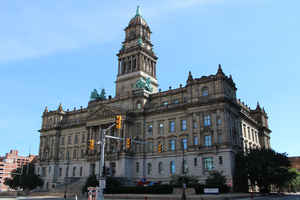Michigan Counties
The boundaries of the eighty-three counties in Michigan have not changed substantially since 1897. Wayne County was the sixth county in the Northwest Territory, formed 15 August 1796 and organized in 1815. Wayne County was created 21 November 1815 as an original county of Michigan.Wayne County, Michigan
Wayne County Education, Geography, and History
Wayne County is the most populous county in the state of Michigan. Based on the 2010 census, its population was 1,820,584, making it the
19th-most populous county in the United States. The 2014 Census update listed the county's population at 1,764,804. The county seat is
Detroit, the most populous city in Michigan and 18th-most populous city in the United States. The county was founded in 1796 and organized in
1815.
Wayne County is included in the Detroit-Warren-Dearborn, MI Metropolitan Statistical Area.
Etymology - Origin of Wayne County Name
Wayne County is named for US General "Mad" Anthony Wayne.
Demographics:
County QuickFacts: CensusBureau Quick Facts
Wayne County History
Wayne County is named for US General "Mad" Anthony Wayne.
Set Off: 1796
Organized: 1815
Wayne County was the sixth county in the Northwest Territory, formed 15 August 1796 from portions of territorial Hamilton County,
territorial Knox County and unorganized territory. It was named for the American general "Mad Anthony" Wayne. It originally encompassed the
entire area of the Lower Peninsula of Michigan, most of the Upper Peninsula, as well as smaller sections that are now part of northern Ohio,
Indiana and Illinois. By proclamation of the Territorial Secretary and Acting Governor, Winthrop Sargent, on August 15, 1796, the boundaries
of Wayne County were declared to begin at the mouth of the Cuyahoga River then west to Fort Wayne, then to the southernmost point of Lake
Michigan and along the western shore north to the territorial boundary in Lake Superior and then along the territorial boundary through Lake
Huron, Lake St. Clair, and Lake Erie back to the starting point.
On January 14, 1803, the Governor of Indiana Territory, William Henry Harrison, issued a similar proclamation defining the boundaries as
beginning at a point where an east and west line passing through the southernmost extreme of Lake Michigan would intersect a north and south
line, passing through the westernmost extreme of the lake, then north to the territorial boundary, then along said boundary line to a point
where an east and west line passing through the southerly extreme of Lake Michigan would intersect the same, then along this last mentioned
line to the place of beginning. This boundary would include Chicago, Illinois and a sizable strip of Wisconsin along Lake Michigan.
These boundaries would be adjusted as Indiana and Illinois became states and as other counties were formed within Michigan Territory.
Geography: Land and Water
As reported by the Census Bureau, the county has a total area of 673 square miles (1,740 km2), of which 612 square miles (1,590 km2) is
land and 61 square miles (160 km2) (9.0%) is water. Its water area includes parts of the Detroit River and Lake St. Clair.
Wayne County borders on Oakland County and Macomb County to the north, Washtenaw County to the west, Essex County, Ontario, Canada to the
east, and Monroe County to the south.
The eastern (and sometimes southern) boundary is a water boundary in the Detroit River and Lake St. Clair with Essex County, Ontario.
Automotive traffic crosses this boundary at the Detroit-Windsor Tunnel and the Ambassador Bridge. Due to the southwestern course of the river,
this small portion of Canada actually lies to the south of Wayne County. The southern communities of the county are usually referred to as
"Downriver", in reference to their location downstream of downtown Detroit.
Grosse Ile is the largest island in Wayne County and is connected to the mainland by the Wayne County Bridge and the Grosse Ile Toll Bridge.
Neighboring Counties
Bordering counties are as follows:
- Washtenaw County (west)
- Monroe County (south)
- Macomb County (northeast)
- Oakland County (northwest)
- Essex County, Ontario (east, southeast)
Education







